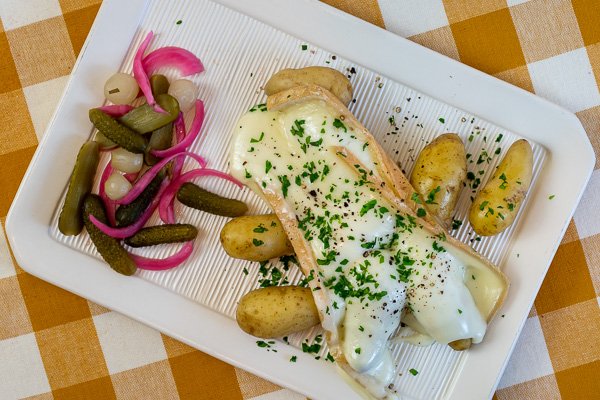When I asked Swiss cheese importer Caroline Hostettler whether she ate raclette as a child in Switzerland, she had no trouble resurrecting a memory. “Everyone had raclette machines at home but us,” recalled Hostettler, sounding still a bit aggrieved several decades later. Her mother refused to make it (she preferred fondue), so the annual raclette at an aunt’s house was the highlight of the year. Hostettler still remembers being almost overcome with excitement.
Today, she makes the dish at her Florida home with Raclette from Switzerland. Of course she does; she imports it. But a new cheese from Vermont’s Jasper Hill Farm is a worthy domestic contender. I used it for the image above and it melts like a dream.
Highlander is modeled after French and Swiss Raclette but with a key difference. The European cheeses are made entirely from cow’s milk; Highlander is part goat’s milk, supplied by a neighboring farm. Highlander is also a raw-milk cheese, which the imports increasingly are not.
Jasper Hill recently purchased two large copper vats from France, the type required for making Comté and other French and Swiss alpine cheeses. Nobody quite understands what the copper contributes—better heat distribution? some chemical reaction?—but as one Jasper Hill staffer told me, cheesemakers swear by the copper’s je ne sais quoi.
Jasper Hill Highlander
The Highlander I sampled (blind) as a judge at last year’s Good Food Awards impressed me greatly. The wedge I used recently for raclette was younger and not as compelling but still with appealing aromas of cultured cream, nuts, sauteed onion and toast. Eaten raw, it seemed salty. Melted and draped over boiled potatoes, like a soft blanket, the salt was welcome. I left the crusty rind on and it was sublime. If you don’t like rinds, sit next to me.
“That’s my favorite part, personally,” says Hostettler. “It has crunch, a big contrast with the gooey part.”
The Raclette that Hostettler imports is square, like Taleggio, not the traditional large wheel. She says Swiss cheesemakers began making the square form to accommodate the square trays of home raclette machines. But trust me: You don’t need a raclette machine. All you need is a broiler, a heavy baking sheet and the right cheese. If you can’t find Jasper Hill Highlander or French or Swiss Raclette, Hostettler recommends Vacherin Fribourgeois or Morbier. Highlander is not widely distributed yet. Some Whole Foods in some regions (Rocky Mountains, Northeast, North Atlantic and Pacific Northwest) have it, as does the Metropolitan Market chain around Seattle, Cheese Corner (Westerly, RI) and, of course, Jasper Hill’s online store.
Raclette for Two
Although two people will likely eat no more than 6 to 8 ounces of cheese, you’ll have an easier time cutting slices from a wedge that weighs at least 1 pound. Enjoy the remaining cheese on sandwiches, on a cheese board or in baked dishes. For a more substantial platter, add sliced prosciutto, bresaola or Serrano ham.
A generous wedge of Jasper Hill Farm Highlander or Swiss or French Raclette
Small fingerling potatoes, as many as you like
Cornichons and pickled pearl onions or Doug’s Pickled Red Onions
Chopped Italian parsley
Coarsely cracked black pepper
Paprika, optional
Preheat a broiler and position a rack 6 to 8 inches from the element. Cut the cheese into slices 1/4 to 1/3 inch thick. Try to make them evenly thick so they melt evenly. Three to four ounces per person is about right. Arrange the slices on a heavy baking sheet (not nonstick).
Put the potatoes in a saucepan with salted water to cover by 1 inch. Bring to a simmer, adjust the heat to maintain a simmer and cook until a skewer pierces them easily, about 15 minutes. Drain them and peel them if you like. (I don’t.) Cut in half lengthwise if desired and arrange on a platter or individual plates. Put the cornichons and onions alongside the potatoes.
Broil the cheese, watching carefully, until the slices visibly soften and just start to slump, less than 2 minutes. If you broil the cheese too long, the fat will seep out. Immediately slide the molten cheese onto the waiting potatoes, which should still be warm. Top with parsley, black pepper and paprika, if using. Eat immediately if not sooner.



